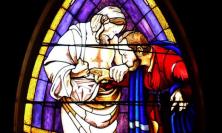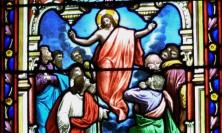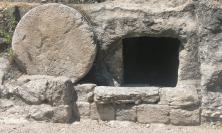
There are many questions which the Gospel accounts of the risen Jesus leave unanswered. When we consider them, however, we realise they are not so much questions about Jesus as questions about human life itself, argues Jesuit philosopher, Gerard J Hughes.
It is an appropriate time of year for Christians to think about resurrection – not just the resurrection of Jesus, fundamental to Christian faith though that is, but also what happens to all of us after we die. Here I offer some lines of thought on both topics; I hope they will be constructive, even if they are inevitably (or so I would argue) less than conclusive. First, then, it will be helpful to look at some of the views about the resurrection of Jesus held by first and second-generation Christians. I shall then offer some thoughts on how any belief in life after death might be related to contemporary issues in philosophy and the sciences.
On what did the early Christians base their faith?
There is a passage in which St Paul, writing to the Christians in Corinth, gives what is probably the earliest version we have of a Christian ‘creed’:
Now I would remind you, brethren, in what terms I preached the gospel which you received, and in which you stand…
For I delivered to you as of first importance what I also received, that Christ died for our sins in accordance with the scriptures, that he was buried, that he was raised on the third day in accordance with the scriptures, and that he appeared to Cephas, then to the twelve; then to more than five hundred brethren at one time, most of whom are still alive, though some have fallen asleep. Then he appeared to James, then to all the apostles. Last of all, as to one untimely born, he appeared also to me. (1 Cor 15: 3-8)
This passage was written perhaps twenty years after the death of Jesus to the Christian community in Corinth, some of whom were inclined to reject belief in the resurrection. There are several quite striking things about it. To begin with, it is clear that the basis of the early Christian faith was the experience of a very large number of people, most of whom are simply not known to us at all. But Paul is careful to point out that some of those who first experienced the risen Christ were still alive and, presumably, could be asked what that had been like. Secondly, the repeated phrase ‘in accordance with the Scriptures’ reflects what we know from elsewhere, that the early Christians in general were profoundly shocked by the death of the man they had come to think of as the long-awaited Messiah. The Messiah was definitely not expected to die a shameful death at the hands of the Roman oppressors, if indeed he was supposed to die at all. The early Christians had to learn to re-read their Jewish tradition to find some pointers – ‘the stone which the builders rejected’, and the ‘Suffering Servant’, for example – to help them to see that perhaps even such an apparent disaster could be somehow made sense of. Thirdly, it is quite remarkable how little correspondence there is between Paul’s long and precise list of people to whom Christ appeared, and the resurrection narratives at the end of the three Gospels, Matthew, Luke and John. They do mention appearances to the apostles – the ‘eleven’ in Matthew, ‘the eleven and their companions’ in Luke, the ‘disciples’ (twice) in John. There is a passing mention of an appearance to Peter (in Luke). But there is no mention in the Gospels of a special appearance to James, let alone to the ‘more than 500 at once’; and in the other direction, there is no mention in Paul’s list of any appearance to the women, or to Mary Magdalen, who are prominent in Matthew and Luke, nor of any appearance in Galilee to correspond to the ones in Matthew and John.
Here is a possible explanation of the difference. Paul talks about Christ appearing to these various people as something which was simply common knowledge to the Christians of his time, without any need to elaborate on it. To judge from the way Paul continues, the controversial point was not that, but rather that some Corinthians found it all very doubtful because they could not imagine what a risen person could possibly be like. So Paul starts by giving the unquestionable list of witnesses, which is his basic move; and in the rest of the chapter, he makes an effort to answer the precise question they were asking: what is a risen person like? I think it fair to say that he flounders more than a bit in trying to give any coherent answer. In contrast, the resurrection narratives in the gospels are, as we shall see, much more interested in interpreting the resurrection than in describing it.
What was meant by ‘seeing’ the risen Jesus?
Surprisingly, perhaps, despite the crowd of witnesses Paul gives, we have almost no first-hand account of what it was like to ‘see’ the risen Jesus. Though Paul puts himself at the end of the list of people to whom Christ appeared, almost as if he were an afterthought, he does not give the impression that the ‘appearance’ to him was any different from the appearances to the others, but when he refers to it again in his letter to the Galatians (Gal 1:13-15), he still gives no detailed description at all. The nearest thing to that which we have are the two more detailed, but second-hand, descriptions of Paul’s experience on the road to Damascus given by Luke in the Acts of the Apostles, one of which he puts in to Paul’s own mouth (Acts 22:1-16; see too 9:1-19): Three things are especially striking about these accounts; the first is that Paul did not in any ordinary sense ‘see’ the risen Jesus:
i) He did not have a vision of his risen body vividly before him, yet he does hot hesitate to describe this as Christ appearing to him as he had to all the others.
ii) He had no doubt whatever about who it was he was dealing with, and who had made such a dramatic impact on him.
iii) Paul’s life was transformed by the experience.
I think that there are very good reasons why Paul’s attempts to describe what a risen person might be like for the benefit of the Corinthians, or his account of his own experience of the risen Jesus are so lacking in detail. I shall offer some suggestions about why that might be so in a few moments. But first it will help to try to understand what the apparently much more vivid passages in the Gospels are doing.
The Gospel Resurrection Narratives: What do they try to do?
The first Christians based their faith on the testimony of the whole host of witnesses mentioned by Paul, not on the resurrection narratives in the Gospels. The Gospels were written for Christians a whole generation later than Paul’s audience, and they take Paul’s list of witnesses for granted. Their aim is to interpret rather than to rehearse yet again the evidence for belief in the resurrection. So Matthew, Luke and John in their quite different ways give dramatised episodes, each of which emphasises a rather different point: that the risen Jesus is the same person as the one to died on the cross – Thomas is invited to feel his wounds; that he is still a human being – he eats honeycomb and fish (of all things!); that human relationships do survive death, however changed they somehow are – the appearance to Mary Magdalen; the re-instatement of Peter), that the Apostles will have a mission to preach, to forgive sins and to hand on the Spirit. It is the significance rather than the fact of the resurrection on which the Gospels focus. The story in Luke of the two disciples walking to Emmaus is an illustrative example. To understand it properly, I suggest we have to think of second or third generation Christians, somewhat disappointed, asking, what it is in their lives which will parallel the experiences of the first disciples such as the ones on Paul’s list? The Emmaus story replies in three points:
i) There really is no need to find the death of Jesus shocking. Praying one’s way through the Jewish scriptures will gradually show you how God’s plan in Jesus was fulfilled, despite what was done to him. The disciples in the Lucan story find this advice heart-warming, their despair relieved.
ii) They recognised Jesus in the Eucharist: and that recognition went hand in hand with not ‘seeing him’; for in that moment of recognition in the story, he disappeared from their eyes. This is of enormous symbolic importance.
iii) Whereas – back in Jerusalem, now, for the scene has rapidly shifted – the apostles said ‘We have seen the Lord’, the two Lucan disciples did not say that they had seen him too, as perhaps one might have expected, but that they had recognised him in the breaking of bread.’
So the story is a kind of dramatised parable rather than a literal description. Second generation Christians have not ‘seen’ the Lord; instead, their way of experiencing his presence is in praying the scriptures, and in celebrating the Eucharist. As the Gospel of John puts it, even to doubting Thomas, ‘Blessed are those who have not seen, and have believed.’ In this respect the second or third generation Christians, or we twenty-first century Christians, have much the same problems. Luke’s advice is just appropriate for us as for the audience for whom he was writing.
Body, Soul and Self
What the risen Jesus might be like, or indeed what it might be like for anyone to survive death, is very far from clear. Put in terms of Jesus’ resurrection or life after death, the question does indeed have very religious overtones; but in fact some of the most difficult problems are not specifically religious problems at all. They are problems with the deepest levels of our picture of ourselves and our place in the material world. The issues remain unresolved, and can divide philosophers, neuroscientists and physicists among themselves, independently of any of their religious beliefs. Here are some of them:
a) What is the connection between our brains and our minds, our conscious thoughts and the electrical impulses in our brain?
On one view, there are two things in particular which the electronic activity in our nervous system, and in particular in our brain, cannot explain. The first is consciousness. One would not expect to discover that the wire linking a lamp to the socket in the wall gives rise to consciousness in the lamp; so why should one expect what is basically the same kind of activity in the nerve fibres of a brain to give rise to conscious awareness in animals? Is the simple increase in complexity really enough to explain such a leap? Again, a crucial feature of our consciousness is that in a unique way it has content: our concepts are meaningful; they refer to things in our world. We can formulate thoughts and say what those thoughts are about – what is technically referred to as their ‘intentionality’. Contrast, for instance, the magnetic states of a computer hard disc. What makes them data rather than a mere pattern of electrical charges? Surely not just the properties of the disc itself: it has to be the fact that we can (though the computer in itself cannot) invest that pattern with meaning. Minds cannot therefore be nothing more than super-computers; something radically different must also be involved. A soul perhaps?
On the other view, such an argument is worthless for two very simple reasons. Firstly, simply to assert that meaning and intentionality and consciousness are functions of a soul as distinct from a brain does nothing to explain intentionality or consciousness; it contributes nothing to our understanding. Merely labelling a problem does not solve it; we would need some account of how is a soul supposed to work, and no such account is on offer. And secondly, what else is there to be discovered? The more we study brains, the more amazingly complex we discover them to be. In the end, consciousness and intentionality will turn out to be nothing more than complex electronic properties, about which doubtless we shall gradually learn more and more as our research goes on. What else could they be? We surely are not waiting for the day we will come across a soul lurking in the neurology lab.
This debate, in my opinion, has reached a kind of stalemate. Supporters of the second position will regard their opponents as abandoning proper science in favour of some kind of vague hankering for an indefinite something more; and the others will reply by suggesting that the reductionist implications of the second view spring from nothing more than mere physicalist dogma.
b) Why the deadlock?
I think there are two fundamental reasons why no great progress has been made in resolving this dispute; and, importantly for our present purposes, neither reason has anything to do with religion. The first concerns the nature of matter itself. We have gradually accustomed ourselves to accepting that e = mc2; but perhaps the very familiarity of Einstein’s equation has made it too easy for us to assume we understand what is involved in such a relationship between mass and energy, and how either of these terms relates to the term ‘matter’ as we use it in ordinary everyday language. Similarly, it is when we are taught that we need to think of matter in some circumstances as a collection of particles but in others as a set of force-fields, depending on what we are trying to explain, that we begin to see the strangeness of something which can turn up under two such apparently different guises. The situation is not eased by scientists who maintain that some particles – gravitons – have to be thought of as having no mass at all, because their ‘impact’, so to speak, travels with the speed of light. Particles with zero mass? Or strings vibrating in ten dimensions? The images, models and metaphors used in science are very many, very useful, and extremely various. They do enable us to systematise, to predict and in an increasing measure to control our world. But in an important sense they do not enable us to explain, in the sense of understand, what such a thing as matter might be like ‘in itself’, given that we need to picture it in such diverse ways. Yet if our understanding of such a basic notion as ‘matter’ is so limited, it follows that we cannot clearly state what it is that a materialist is denying, or someone who wishes to reject materialism would have to assert. The kind of empiricist dogma, that every aspect of reality must in the last analysis be accessible to the methods of physics, no longer seems an obvious truth, not even when we are thinking about matter itself, let alone about consciousness or intentionality.
The second reason for the deadlock follows from the first. We do not have a clear general account of the notion of explanation, and in particular, of what counts as an adequate explanation of something. When can one justifiably say that there is nothing more to be explained? Whether neuroscience can or cannot provide an adequate explanation of consciousness and intentionality is, therefore, itself not a clear question; unsurprisingly, neither does it have a clear-cut answer. (And by the same token, we do not really know what would count as an ‘adequate explanation’ of the universe itself. But that is another story!)
c) So, under what conditions can I remain myself?
At least in my own view, and with due apologies to Plato, it seems that we humans are essentially bodily beings. There are manifold difficulties in trying to spell out the relations between our brains and our minds, our selves and our bodies; but it is surely undeniable that even our most personal activities are necessarily embodied. Sensing, feeling, thinking, deciding, all of them depend on bodily mechanisms, even should it prove to be true that they are not identical with those mechanisms. We are inescapably material beings – whatever precisely ‘material’ might mean. Thus. not merely am I embodied in a way that is specifically human, and with a DNA structure which is unique to me (since I have no identical twin). My personal memories and the experiences of my earthly life, and of the people I have known and loved are stored in my brain. It seems that to preserve my identity these structures must somehow always be present.
That the conditions of my survival after death must in some sense be material conditions is clear enough, then. But for the reasons I have given, I would claim that we do not have a very good grasp of the various ways under which matter itself can exist. That is why we are not in a position to say more precisely what such a post-death material existence might be like, nor how it might or might not be linked to the four dimensions of space-time which we currently experience. The universe is deeply mysterious. So it is not so very surprising, that Paul’s own attempts to speculate about what a risen body might be like (1 Cor 15:35-58) themselves use models and metaphors which are not of much help. Neither is it astonishing that his experience of the risen Christ, though he found it unmistakeable and beyond doubt, was not described in terms of any visual imagery at all.
Back to Luke
The notion of resurrection is beyond our grasp; and belief in the resurrection is, as the early creed cited by Paul says, ultimately based on the experience of the earliest Christians. But I believe it is important to see that at least a good deal of the mystery is there before we ask any religious questions at all; it is our material universe and our place in that universe which, for all the amazing progress made by our scientific endeavours, seems almost more mysterious to us than it would have done to Paul or Luke. Yet the disciples as Luke depicts them on the road to Emmaus can, through their meditation on the scriptures and their sharing in the eucharist, open themselves to an experience of God. That is what enables us, who have not seen, nonetheless to believe. Perhaps also it points us towards a hope that transcends anything we can say, whether in science or in religion.
Gerard J Hughes SJ was head of the philosophy department at Heythrop College, University of London, and is currently tutor in philosophy at Campion Hall, Oxford. He is the author of Aristotle on Ethics (Routledge, 2001) and Is God to Blame? (Veritas, 2007).
![]() Campion Hall, Oxford
Campion Hall, Oxford
![]() Heythrop College, University of London
Heythrop College, University of London
![]() Is God to Blame? by Gerard J Hughes
Is God to Blame? by Gerard J Hughes
![]() Aristotle on Ethics by Gerard J Hughes
Aristotle on Ethics by Gerard J Hughes





